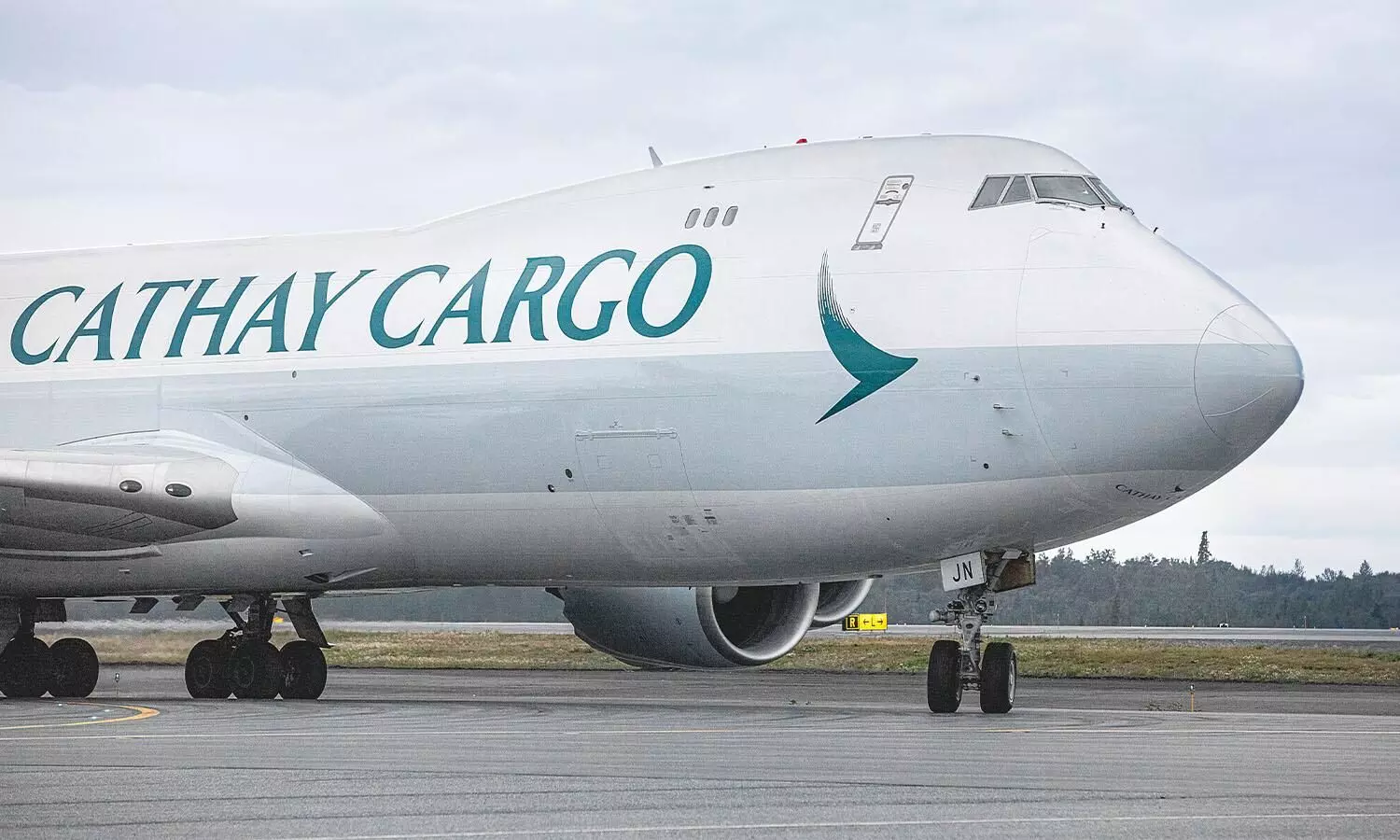
Scripting a spirited comeback: Cathay Cargo story
Crippled by the Covid pandemic, Cathay Cargo played a key role in Cathay Pacific bouncing back to normalcy by 2024.

Cathay Pacific scripted one of the strongest bounce backs from the crippling Covid pandemic in 2024 with the airline not only repaying all money raised from the Hong Kong Special Administrative Region of China (SAR) government but also hitting new highs every month in cargo operations.
Cathay Pacific carried 142,601 tonnes of cargo in November 2024, an increase of 15 percent compared with November 2023. While revenue tonne kilometres (RFTKs) increased 11.9 percent year on year, load factor increased by 1.2 percentage points to 62.3 percent while available cargo tonne kilometres (AFTKs) increased by 9.8 percent year on year.
“In terms of cargo, November tonnage was at similar levels to the previous month but was 15% higher year on year," says Lavinia Lau, Chief Customer and Commercial Officer, Cathay Pacific. "We observed healthy market momentum during the peak season, particularly from Hong Kong and other cities in the Greater Bay Area (GBA) driven by e-commerce sales events.
“There was high demand for perishables from the Americas and Southwest Pacific, with significant deliveries to Hong Kong and other regional routes in Asia. Additionally, we observed an increase in tonnage of our Cathay Expert solution due to transportation of machinery and engines, especially from Japan. Our mail volumes also started to rise as we approached the festive season.
“November also saw the successful launch of our new marketing campaign for Cathay Courier following the special solution’s relaunch in July this year, with our first video showcasing our time-sensitive delivery capabilities."
For the first 11 months of 2024, tonnage increased by 10.9 percent to 1,388,501 tonnes on 8.9 percent increase in AFTKs and a 4.8 percent increase in RFTKs compared with the same period for 2023.
The start of 2024 was not forecast to be great, but by late 2024, demand for air cargo rose significantly due to e-commerce, says Tom Owen, Cathay Cargo Director. "Over the past 12-18 months, e-commerce has driven the industry, with higher-than-expected summer demand and early goods movements. Last year, we achieved our highest weekly results much earlier than in 2023.
"The end of November 2024 saw the commissioning of the Three-Runway System at HKIA, which gives us the capacity to grow, and for Hong Kong to maintain and develop its status as the world’s top air cargo hub and the gateway for the GBA.
"We remain confident in and mindful of everything that’s been achieved in the past year, while recognising the need to stay on top of our game and be prepared for any changes in circumstances."
The Cathay Group has committed more than HK$100 billion ($13 billion) in investments over the next seven years as part of its strategy to elevate customer experience, and strengthen Hong Kong’s international aviation hub status riding on the Three-Runway System. This will include major investments in its fleet, digital and sustainability as it sets sights on growing for its customers, employees and its home, Hong Kong. Cathay now has more than 100 new-generation aircraft in its delivery pipeline, with the right to acquire over 80 additional aircraft in future.
As a Group, Cathay reported an attributable profit of HK$3.6 billion ($468 million) in the first half of 2024 compared to a profit of HK$4.3 billion in the first half of 2023.
Bouncing back from the pandemic
Cathay Pacific was the worst affected due to the Covid pandemic, particularly in maintaining cargo operations amid stringent quarantine requirements and limited airfreight capacity.
"To adapt, we maximised the flexibility of our fleet, deploying 20 B747 freighters, converted “preighters”, and cargo-only passenger aircraft to keep critical supply chains moving," says Owen. "Key initiatives like our digital transformation programme launched in 2019 were accelerated during this period, enabling innovations such as the Click and Ship booking engine linking to customers’ own systems through direct API connections and smart ULD tracking. These steps enhanced efficiency and responsiveness to customer demands."
As Cathay Cargo captured the growth in the pharmaceutical markets, it refreshed the Cathay Pharma solution. "There have also been infrastructural developments, with the opening of the new pharma handling centre at the Cathay Cargo Terminal, the largest such facility at Hong Kong International Airport."
Cathay Pharma is divided under two simplified headings – Active and Passive. The Active solution uses active containers with thermostatic mechanisms while passive uses passive coolants and insulation to maintain temperature. Bookings made under both Active and Passive include expedient ground handling and priority tarmac transfers to limit the risk of temperature excursions while shipments are exposed to ambient outdoor temperatures.
Cathay Pharma offers four transportation temperature ranges to suit the most common types of pharma shipments including extended room temperature (ERT) - +2°C to +25°C – which is available in response to demand from customers.
Moves in tandem with Hong Kong SAR government
During the pandemic, Cathay's collaboration with the Hong Kong Special Administrative Region of China (SAR) government proved to be crucial in navigating the challenges faced. "The strict quarantine measures for aircrew in 2021 significantly impacted capacity," says Owen. "Despite these constraints, we managed to sustain operations by repurposing passenger aircraft for cargo-only flights and leveraging partnerships with our wholly-owned subsidiary Air Hong Kong for charter services. Our employees played a pivotal role during this period, demonstrating incredible adaptability and commitment.
"We understand keeping our people active and engaged is key to our future success, and we are pleased to report a positive trend in our employee engagement performance over the past year, reflecting our commitment to fostering a supportive work environment.
"The Cathay Group fully repaid the Hong Kong SAR government’s HK$19.5 billion investment in 2024, in addition to paying HK$2.44 billion in preference share dividends to the government over its holding period and repurchasing the warrants for a total consideration of HK$1.53 billion.
"Cargo operations were instrumental to Cathay’s business during the pandemic. Despite passenger travel being severely restricted, our cargo arm maintained supply chain continuity, contributing significantly to the Group’s profitability in the second half of 2021. Key decisions such as diversifying fleet usage and expanding digital capabilities allowed us to maintain operational efficiency while meeting rising demand for goods like pharmaceuticals and e-commerce shipments. This proactive approach ensured we remained agile and financially stable, facilitating the repayment of the Government’s investment in Cathay.
"In 2023, Hong Kong retained its status as the world’s busiest air cargo hub, handling 4.3 million tonnes of cargo, which accounted for about 47 percent, or about HK$4,160 billion ($541 billion), of the total value of Hong Kong's external trade, with Cathay Cargo being the largest contributor at 1.4 million tonnes."
We anticipate that e-commerce will remain a significant driver of growth in 2025 and beyond. On the other hand, we remain vigilant and adaptable to potential changes influenced by geopolitical factors that could impact trade flows.
Tom Owen, Cathay Cargo
E-commerce story to continue
E-commerce continues to grow exponentially, with the GBA being a key engine for exports. "Supported by the burgeoning e-commerce market, Hong Kong’s traditional strong lanes to the USA and Europe remain intact," adds Owen. "China’s position as the manufacturing hub of the world provides impetus and reliability to the traditional consumer markets of North America and Europe as well as – to a smaller extent, Australia, New Zealand and high-income consumer markets like the UAE and Singapore. Cathay Cargo also has traditional strength throughout its network by helping to connect South East Asia, South Asia and North Asia to the world.
"We anticipate that e-commerce will remain a significant driver of growth in 2025 and beyond. On the other hand, we remain vigilant and adaptable to potential changes influenced by geopolitical factors that could impact trade flows."
The key trunk trade lanes for Cathay Cargo continue to be Asia to Transpacific and Asia to Europe. "We also observe good momentum on iIntra-Asia traffic. While e-commerce traffic has been significant, Cathay Cargo continues to diversify our offerings to serve a wide range of commodities and industry sectors. Our focus will continue to be on our special product offerings such as pharmaceuticals, perishables, live animals, odd-sized cargo and dangerous goods."
Betting on SAF
Cathay Cargo continued to power ahead with the use of sustainable aviation fuel (SAF) in 2024 towards its move for sustainable operations.
Cathay Cargo and DB Schenker jointly held a signing ceremony on October 8, 204 at the airline’s Cathay City headquarters to mark the global forwarder’s membership of the Cathay corporate SAF programme.
“We are delighted to welcome DB Schenker here not only as the newest member of the Cathay corporate SAF programme, but also as its biggest contributor," Owen said after signing the agreement. "It is great to have this level of support from such an important player in the air cargo industry as we work together to decarbonise aviation. This ceremony marks our appreciation for DB Schenker’s significant contribution to our collective efforts to fly greener together.”
Earlier, Dimerco Express Group announced its partnership with Acer and Cathay Cargo to reduce carbon emissions through the use of SAF.
“We are delighted to welcome Acer to our corporate SAF programme through its partnership with Dimerco Express Group, which joined our programme last year," Owen said after the signing of the agreement. "We believe that partnerships such as this along the supply chain are essential if we are to achieve our own and the aviation industry’s stretching targets to decarbonise operations. We are ready to support all of our forwarder and shipper customers in achieving their own sustainability goals through the use of SAF, which is one of the most effective ways to contribute to the aviation industry’s transition to a greener future through the reduction of net emissions.”
Expanding team
Siddhant Iyer, Head of Cargo Markets & Customer Solutions, Cathay Cargo will be taking up the role of Head of Cargo Global Partnerships. "Siddhant’s wealth of experience in the region shall prove invaluable in building further on the relationships with our global partners," Cathay Cargo says in a LinkedIn post.
Iyer has over 15 years of experience with Cathay Cargo having started as Area Services Manager from Bengaluru, India.
Iyer will be taking from Chris Bowden who will be moving to Hong Kong Aircraft Engineering Company (HAECO), and promoted to the role of Group General Manager, Safety & Quality w.e.f March 2025. HEACO is one of the world’s leading aircraft engineering and maintenance service providers. Bowden has over six years of experience with the Cathay Group.
Awaiting arrival of A350Fs
Cathay Cargo has placed a firm order for six new-generation A350 freighters with an option to acquire 20 more aircraft. The orders will start delivering from 2027 and further strengthen Hong Kong's status as the world's number one cargo hub.
The freighters will link Hong Kong and the Chinese Mainland with long-haul destinations in North and South America as well as Europe. The purchase agreement brings the Cathay Group’s new aircraft deliveries to 77.
Cathay Cargo has a freighter fleet of 20 Boeing 747 freighters including 14 B747-8Fs and six B747-400ERFs. In addition to freighter capacity, Cathay Cargo provides belly capacity through the Cathay Group’s passenger network, providing cargo services to around 80 destinations worldwide.
Owen says: "We remain confident in the long-term demand outlook for Asia to America, Asia to Europe as well as intra-Asia markets. The additional freighter aircraft will enhance our existing freighter and passenger belly capacity, allowing us to meet the growing air freight demand in the medium- to long-term."

